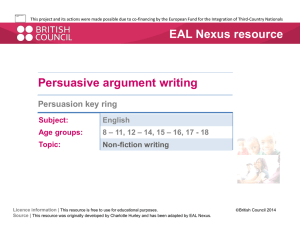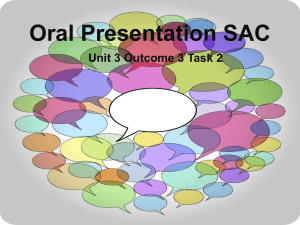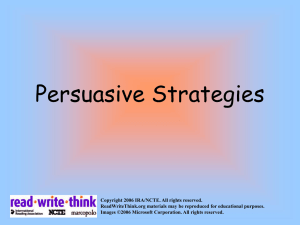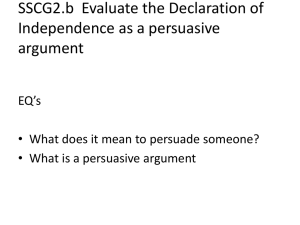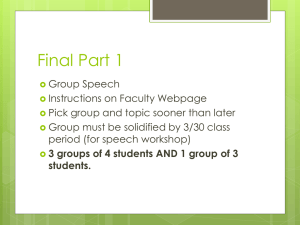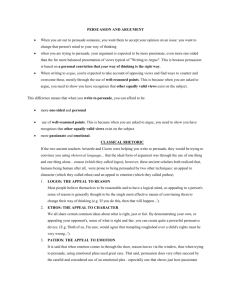Grade 7 - Finding solutions to food waste
advertisement
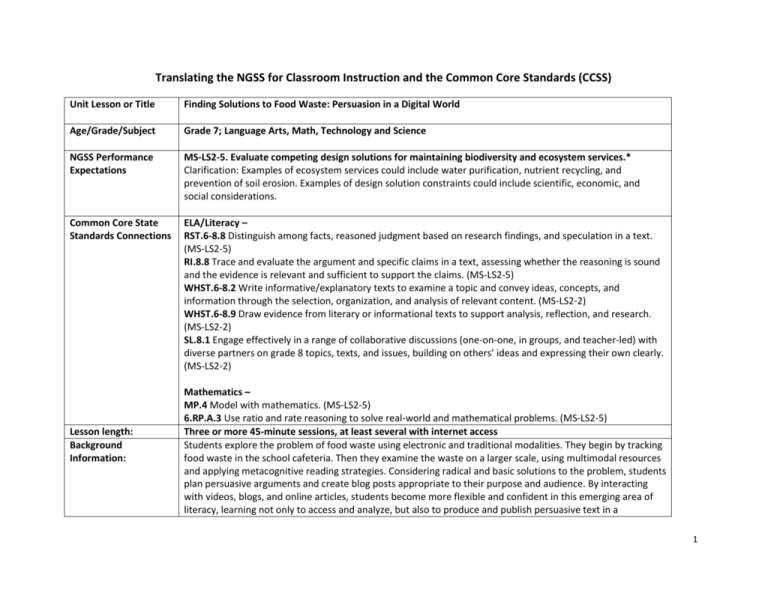
Translating the NGSS for Classroom Instruction and the Common Core Standards (CCSS) Unit Lesson or Title Finding Solutions to Food Waste: Persuasion in a Digital World Age/Grade/Subject Grade 7; Language Arts, Math, Technology and Science NGSS Performance Expectations MS-LS2-5. Evaluate competing design solutions for maintaining biodiversity and ecosystem services.* Clarification: Examples of ecosystem services could include water purification, nutrient recycling, and prevention of soil erosion. Examples of design solution constraints could include scientific, economic, and social considerations. Common Core State Standards Connections ELA/Literacy – RST.6-8.8 Distinguish among facts, reasoned judgment based on research findings, and speculation in a text. (MS-LS2-5) RI.8.8 Trace and evaluate the argument and specific claims in a text, assessing whether the reasoning is sound and the evidence is relevant and sufficient to support the claims. (MS-LS2-5) WHST.6-8.2 Write informative/explanatory texts to examine a topic and convey ideas, concepts, and information through the selection, organization, and analysis of relevant content. (MS-LS2-2) WHST.6-8.9 Draw evidence from literary or informational texts to support analysis, reflection, and research. (MS-LS2-2) SL.8.1 Engage effectively in a range of collaborative discussions (one-on-one, in groups, and teacher-led) with diverse partners on grade 8 topics, texts, and issues, building on others’ ideas and expressing their own clearly. (MS-LS2-2) Lesson length: Background Information: Mathematics – MP.4 Model with mathematics. (MS-LS2-5) 6.RP.A.3 Use ratio and rate reasoning to solve real-world and mathematical problems. (MS-LS2-5) Three or more 45-minute sessions, at least several with internet access Students explore the problem of food waste using electronic and traditional modalities. They begin by tracking food waste in the school cafeteria. Then they examine the waste on a larger scale, using multimodal resources and applying metacognitive reading strategies. Considering radical and basic solutions to the problem, students plan persuasive arguments and create blog posts appropriate to their purpose and audience. By interacting with videos, blogs, and online articles, students become more flexible and confident in this emerging area of literacy, learning not only to access and analyze, but also to produce and publish persuasive text in a 1 multimodal environment. http://www.readwritethink.org/classroom-resources/lesson-plans/findingsolutions-food-waste-30950.html (Perdomo, 2014) Disciplinary Core Ideas LS2.C: Ecosystem Dynamics, Functioning, and Resilience Biodiversity describes the variety of species found in Earth’s terrestrial and oceanic ecosystems. The completeness or integrity of an ecosystem’s biodiversity is often used as a measure of its health. (MS-LS2-5) LS4.D: Biodiversity and Humans Changes in biodiversity can influence humans’ resources, such as food, energy, and medicines, as well as ecosystem services that humans rely on—for example, water purification and recycling. (secondary to MS-LS25) ETS1.B: Developing Possible Solutions There are systematic processes for evaluating solutions with respect to how well they meet the criteria and constraints of a problem. (secondary to MS-LS2-5) Science and Engineering Practice Cross Cutting Concepts Engaging in Argument from Evidence Engaging in argument from evidence in 6–8 builds on K–5 experiences and progresses to constructing a convincing argument that supports or refutes claims for either explanations or solutions about the natural and designed world(s). Evaluate competing design solutions based on jointly developed and agreed-upon design criteria. (MS-LS2-5) Influence of Science, Engineering, and Technology on Society and the Natural World The use of technologies and any limitations on their use are driven by individual or societal needs, desires, and values; by the findings of scientific research; and by differences in such factors as climate, natural resources, and economic conditions. Thus technology use varies from region to region and over time. (MSLS2-5) Science Addresses Questions About the Natural and Material World Scientific knowledge can describe the consequences of actions but does not necessarily prescribe the decisions that society takes. (MS-LS2-5) 5E Stage Science/Engineering Practice or Crosscutting What the Teacher Does… What the Students Do…. What Are Students Learning? What is the Evidence of 2 Engage Lesson 1: Engaging in Argument from Evidence Engaging in argument from evidence in 6–8 builds on K–5 experiences and progresses to constructing a convincing argument that supports or refutes claims for either explanations or solutions about the natural and designed world(s). Evaluate competing design solutions based on jointly developed and greed-upon design criteria. (MS-LS2-5) MP.4 Model with mathematics. (MS-LS2-5) 6.RP.A.3 Use ratio and rate reasoning to solve real-world and mathematical problems. (MS-LS2-5) Lesson 2: RST.6-8.8 Distinguish among facts, reasoned judgment based on research findings, and speculation in a text. (MSLS2-5) Lesson 1: Have students to conduct a personal survey of the amount of food they throw away each day at lunch using the Cafeteria Waste Activity Sheet Lesson 1: Students will conduct the survey; then gather information in group of three to five, placing in their science logs. Students will create a pie chart of the ratios. Place students in groups of three to five. Lesson 2: Students will take notes in pairs on the art of “Persuasive Writing” Lesson 2: Teach persuasion basics using The Art of Persuasive Writing PowerPoint presentation, having students take notes. [ This can be completed independently for some students]. Learning? Building schemas between prior knowledge and experiences and new knowledge. Lesson 1 and 2: Chart with ratios and percentages, surveys and notes. Students will discuss their experiences with slides: 3-8. On slide 16, students will form think-pair-share groups and share their personal meaning of the vocabulary. Stop frequently to allow students to share their own examples of persuasive speech. [Use the presentation notes included at the bottom of some of the slides to guide your discussion.] 3 Explore Explain SL.8.1 Engage effectively in a range of collaborative discussions (one-on-one, in groups, and teacherled) with diverse partners on grade 8 topics, texts, and issues, building on others’ ideas and expressing their own clearly. (MS-LS2-2) Lessons 1 and 2 : ETS1.B: Developing Possible Solutions There are systematic processes for evaluating solutions with respect to how well they meet the criteria and constraints of a problem. (secondary to MS-LS2-5) Teacher will check on prior knowledge of vocabulary: persuasive vocabulary like logos, pathos, ethos, and counterarguments. Lesson 1: Every day for five days, have each group record their wasted trash in their science journals Lesson 2: Help students to perfect their thesis statement on slide 13. On slide 16, after the think-pair-share groups, the class will come to a consensus of each word’s meaning placing them on the board or chart in front . Lesson 1: 6.RP.A.3 Use Lesson 1: Teacher will list ratio and rate reasoning to percentages on a chart at solve real-world and the front of the room as mathematical problems. well as ratios so students (MS-LS2-5) may refer to it as they Lesson 1: After five days, compile and analyze the information they have collected. Lesson 2: Each student will create a rough thesis statement of his or her choice using slide 13 in their writing journals. Lesson 1: Each group determines the overall percentage of food wasted over the last five days. Building connections between prior knowledge and new knowledge through the senses-kinesthetic (Using Gardnerlearning styles and metacognition—to build schemas). Lesson 1: Science log Lesson 2: Rough thesis in journal and chart. Students interact in a way that supports conceptual advancement and assimilation of knowledge. 4 work. Lesson 2: SL.8.1 Engage effectively in a range of collaborative discussions (one-on-one, in groups, and teacher-led) with diverse partners on grade 8 topics, texts, and issues, building on others’ ideas and expressing their own clearly. (MS-LS2-2) Elaborate Lesson 1: Evaluate competing design solutions based on jointly developed and agreedupon design criteria. (MSLS2-5) Lesson 2: WHST.6-8.2 Write informative/explanatory texts to examine a topic and convey ideas, concepts, and information through the selection, organization, and analysis of relevant content. (MSLS2-2) Evaluate Lesson 1 and 2: LS4.D: Lesson 2: Slide 13: Have students create an arguable thesis statement based on their knowledge [this can be changed later]. Slide 16: Teacher will then show slides 17-21 and ask the students how close the class’s meanings were to the slides? Lesson 1: Teacher will facilitate understanding for each group by asking the students to summarize their findings. Lesson 2: Class will choose one student thesis and develop it in outline format: three topics, a conclusion and organization in an argument. Lesson 1: Have the class Lesson 2: Students will engage in a discussion over their meaning; how word meaning develops, and its importance in an argument (emotional words) and group consensus. Lesson 1: Each group will synthesize their findings into a pie chart that can be displayed. Lesson 2: Students will think and elaborate on their thesis statements with three examples from prior knowledge. Partner check. Lesson 1: This activity proceeds the time for sharing responses with the whole class and synthesis of information. Lesson 2: An arguable thesis statement and chart of word meanings. Students integrate expert and go beyond given information to generate and improve their ideas as is evidenced by the chart that lists the three examples of a persuasive essay Lesson 1: outline or graphic organizers. Lesson 2: Three examples to integrate in the body of the student’s essay found in journals and on chart. Lesson 1: As a whole group, Lesson 1: Science logs and 5 Biodiversity and Humans Changes in biodiversity can influence humans’ resources, such as food, energy, and medicines, as well as ecosystem services that humans rely on—for example, water purification and recycling. (secondary to MS-LS2-5) Lesson 2: RI.8.8 Trace and evaluate the argument and specific claims in a text, assessing whether the reasoning is sound and the evidence is relevant and sufficient to support the claims. (MSLS2-5) draw conclusions about the pie graphs, ratios, and percentages by compiling the results as a class in relation to recycling excess trash. Lesson 2: Have students review the components of an argument and arrange their thesis and support in the correct main divisions. the class will draw conclusions about all of the findings as they examine the charts. Lesson 2: Students will place their example essay and original thesis in their journals. students’ activity sheets for assessment. Lesson 2: Chart, sample essay, thesis statements and selfreflection of process and notes in journal writing. Students will self-reflect on the process so far in their journals Grouping Strategies Think-pair-share Whole Discourse group Book Partners (reading) Individual Materials and Equipment Chart paper and markers, the Cafeteria Waste Activity Sheet, The Art of Persuasive Writing PowerPoint presentation (click on link), Internet Access and screen, TED Talk: Marcel Dicke: Why Not Eat Insects? Film (can download at home), Why Not Eat Insects? Notes Organizer, the ReadWriteThink Persuasion Map (Interactive), articles : Food Facts: Your Scraps Add Up, Food Waste Basics, and the Waste Not, Want Not (click on hyperlinks), the Metacognitive Strategies Chart, the Research Guide, example of blog: Waste Not, Want Not , ReadWriteThink Persuasion Map and writing tools. Lesson 1: Waste in the Cafeteria Survey Description of Performance Tasks 6 Note: The performance tasks should include elements from the three dimensions from the NGSS – knowing and doing Assign students to conduct a personal survey of the amount of food they throw away each day at lunch using the Cafeteria Waste Activity Sheet After five days of data collection, divide students into groups of three to five. Have them compile and analyze the information they have collected by determining the overall percentage of food wasted over the last five days. Have each group of students synthesize their findings into a pie chart that can be displayed. Have the class draw conclusions about the findings as they examine the charts. Collect students’ activity sheets for assessment. Lesson 2: Power point Presentation (Scaffolding Information) Teach persuasion basics using The Art of Persuasive Writing PowerPoint presentation, having students take notes. Use the presentation notes included at the bottom of some of the slides to guide your discussion. Stop frequently to allow students to share their own examples of persuasive speech. Presentation highlights include types of persuasive speech, elements of the persuasive essay, and persuasive vocabulary like logos, pathos, ethos, and counterarguments. Lesson 3: Watch TED Talk: Marcel Dicke: Why Not Eat Insects? as a class. As they watch the video, have students take notes using the Why Not Eat Insects? Notes Organizer After watching the video, discuss the presenter’s purpose and intended audience with students Have students use their notes to fill in the ReadWriteThink Persuasion Map, identifying the thesis and major supporting arguments. Collect their notes organizers for assessment Lesson 4-5: Set a purpose for reading the following articles: Food Facts: Your Scraps Add Up, Food Waste Basics, and the Waste Not, Want Not blog. Review what students know about food waste. Partners: Review the four metacognitive strategies in the Metacognitive Strategies Chart: connect, question, infer, and evaluate. Remind students to preview the articles by reading the titles, examining the graphics, and reading the captions. Have students explore the online articles for answers to the food waste problem. Briefly model the 7 process of collecting information from the online articles Have students record their findings on the Research Guide Lesson 5 Briefly model the process of developing a single, focused thesis and arguments from the Research Guide. Some students may want to tackle all of the issues discovered in their research, so you should provide the necessary scaffolding as students work to narrow their focus. (Please note that the focus of Waste Not, Want Not is reducing food waste at home; however, students should be free to choose any food waste topic from their research when writing their own blogs.) Have students develop a thesis and arguments for their own blog post, offering persuasive solutions to the waste problem. Students should refer to facts from the Research Guide to craft their arguments. Have students consider the appropriate tone for their electronic audience. Since students are addressing their own academic community about a social issue, the tone should be thoughtful and insightful. Caution students to avoid informal or flippant remarks. Students may use the ReadWriteThink Persuasion Map to plan their blog. If a computer lab is not available, students use a hard-copy: See hyperlink under “Background” for the rest of the lesson plans. Supporting English Learners Reading or Writing Activity Listed in Learning and Instructional Sequence Support for Emerging learners Support for Expanding learners Support for Bridging learners Supporting Struggling Learners Activity Support for Students who Need Minor Support Supports for Students who Need Intensive Support 8 Write the word or draw a picture on a sheet of chart paper Internet interactive Reflection, science log writing, group discussions Grouping Adult supervision Cooperative pairing with more advanced learner Partners and labor divisions Adult supervision Adult supervision Research in groups of 3-5 Cooperative groups: division of jobs Internet aids via IRA (International Reading Association) Supporting Advanced Learners Activity Listed in Learning and Instructional Sequence Extension for Advanced Students Find and deconstruct another TED Talk video about reducing waste or recycling. 9

